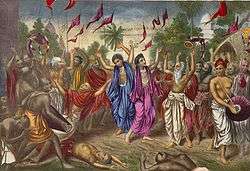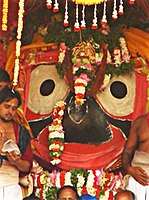Nitai
Śrī Nityānānda Rama Prabhu (Bengali: শ্রী নিত্যানন্দ, b 1474 CE), is the Supreme Personality of Godhead, famous as a primary religious figure within the Gaudiya Vaishnava tradition of Bengal, being an expansion of Balarama.[1] Nitai was Chaitanya Mahaprabhu's friend and disciple. They are often mentioned together as Gaura-Nitai (Gaura, "golden one", referring to Chaitanya, Nitai being a shortened form of Nityananda Rama) or Nimai-Nitai (Nimai being another name of Chaitanya).[2] Followers often refer to Nitai as 'Sri Nityananda', 'Prabhu Nityananda' or 'Nityananda Rama'.
Śrī Nityānānda Rama Prabhu | |
|---|---|
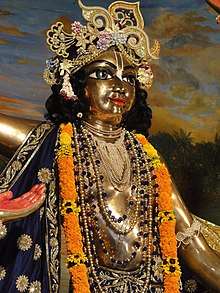 Archa-Vigraha of Śrī Nityānānda Prabhu, ISKCON Mayapur | |
| Personal | |
| Born | circa 1474 Radhadesh, West Bengal, India |
| Religion | Hinduism |
| Known for | Expounded Gaudiya Vaishnavism, Bhakti yoga along with Śrī Kṛṣṇa Caitanya Mahaprabhu and Śrī Advaita Ācārya |
| Philosophy | Bhakti yoga, Achintya Bheda Abheda |
| Religious career | |
| Guru | Madhavendra Puri (mantra guru) |
| Associates | Śrī Advaita Ācārya, Śrī Kṛṣṇa Caitanya Mahaprabhu, Śrī Gadadhāra Pandita, Śrīvāsa Thakura, Haridasa Thakur and others |
| Part of a series on |
| Vaishnavism |
|---|
 |
|
Holy scriptures
|
|
Sampradayas
|
|
Related traditions |
|
|
| Part of a series on | |
| Hindu philosophy | |
|---|---|
 | |
| Orthodox | |
|
|
|
| Heterodox | |
|
|
|
|
|
|
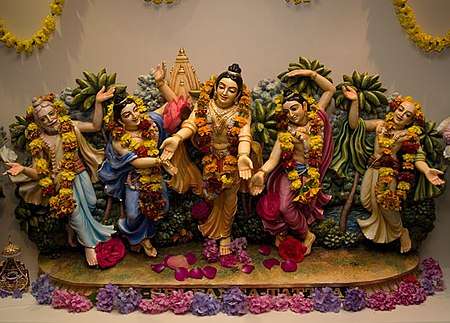
According to Gaudiya-Vaishnava tradition Śrī Nityānānda Rama is an incarnation of Balarama, with Chaitanya Mahaprabhu being his eternal brother and friend, Krishna.[3] He is considered the 'most merciful' incarnation of the Supreme Personality of Godhead [4] (a term popularized by A.C. Bhaktivedanta Swami).
Śrīla Bhaktisiddhanta Sarasvati Ṭhākura Prabhupāda writes: “Nityananda is the Primary Manifestive Constituent of the Divinity. Nityananda alone possesses the distinctive function of the guru. In Nityananda the function is embodied. Nityananda is the servant-God.”[5]
Life
Nityananda Rama Prabhu appeared to a religious Bengali Brahmin, known as Pandit Hadai and Padmavati[6] in Ekachakra[7] (a small village in Birbhum district of present West Bengal) around the year 1474. His devotion and great talent for singing Vaishnava hymns (bhajan) were apparent from a very early age. In his youth, he would generally play the part of Lakshman, Rama's younger brother, in dramatic re-enactments of Lord Rama's pastimes, along with the other boys of Ekachakra.
At the age of thirteen, Nitai left home with a travelling renunciate (sannyasi) known as Lakshmipati Tirtha. Nitai's father, Hadai Pandit, had offered the travelling sannyasi anything he wished as a gift. To this, Lakshmipati Tirtha replied that he was in need of someone to assist him in his travels to the holy places (he was about to begin a pilgrimage) and that Nitai would be perfect for the job. As he had given his word, Hadai Pandit reluctantly agreed and Nitai joined him in his travels. This started Nitai's long physical and spiritual journey through India, which would get him in contact with important Gurus of the Vaishnava tradition. Apart from Lakshmipati Tirtha, who at some point initiated him, he was also associated with Lakshmipati Tirtha's famous other disciples: Madhavendra Puri, Advaita Acharya, and Ishvara Puri, the spiritual master of Chaitanya Mahaprabhu.
Jagai-Madhai episode
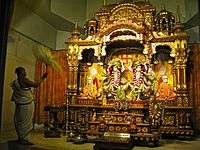
The episode of Jagai-Madhai relates to Chaitanya and Nitai. There are a few versions of the story, but the basics outline of the traditional tale is as follows:
- Once, while chanting the name of Krishna in the streets, Nitai was attacked by Jagai and Madhai, two irreverent drunk brothers. Madhai threw an earthen pot, which cut his forehead. At this, point Nitai is said to have uttered the now famous sentence, "Merechhish kolshir kana, tai bole ki prem debona?" (Shall I stop giving you love because you have hit me with an earthen pot?). Chaitanya heard of the episode, flew to a rage, and wanted to kill the brothers with his divine Chakra. Nitai begged him to pardon them and they became Chaitanya's disciples, converted by Nitai's compassion.
Marriage and descendants
| Part of a series on |
| Vaishnavism |
|---|
 |
|
Holy scriptures
|
|
Sampradayas
|
|
Related traditions |
|
|
%2C_Mata_Janhava_(right).jpg)
Nitai married two daughters of Suryadasa Sarakhela, Vasudha and Jahnava. After marriage, he settled in Khardaha in 24 Parganas district in West Bengal. He had a son, Virachandra Goswami or Virabhadra, and a daughter, Ganga, by his first wife, Vasudha. Virabhadra was later initiated to Vaishnava rites by his stepmother Jahnava.[8]
Legacy
The exploits of Chaitanya and Nitai have had deep religious and cultural implications in Bengal. They are credited with the revival of Hinduism in Eastern India, plagued mainly by the caste system, which they denounced. Much of Vaishnava literature, regarded as one the finest literary heritage of medieval Bengal, came from them or their disciples. Even in secular literature, their brotherly love towards each other has been celebrated. As Bhakti Ananda Goswami expresses the Gaudiya Vaishnava view of Nitai, “Nityananda-Balarama has broken-open and plundered the Store House of the Holy Name! He has distributed the Contents without any regard for those who are qualified or unworthy to receive The Great Treasure of The Holy Name of HARI !”[9]
Principal sobriquets
- Nityananda -- He Who embodies eternal bliss
- Avadhutendu -- The Moon of divine madmen
- Vasudha-prana-vallabha -- The beloved of the life-breath of Vasudha
- Jahnavi-jivita-pati -- The eternal divine husband of Shrimati Jahnavi-devi and the maintainer and sustainer of Her life and soul
- Krsna-prema-prada -- He Who bestows ecstatic love for Krishna
- Prabhu -- The Lord and Master of the devotees
- Padmavati-suta -- The dear son of Padmavati
- Sriman -- He of splendorous transcendental majesty
- Saci-nandana-purvaja -- The older brother of mother Saci's son
- Bhavonmatta -- He Who is maddened in overwhelming ecstatic emotions
- Jagat-trata -- The savior of the universe
- Rakta-gaura-kalevara - He Whose complexion is golden tinged with red
These words from the writings of Sarvabhauma Bhattacharya, are usually combined into a single prayer:
Nityananda vadhutendur,
vasudha-prana-vallabha
jahnavi-jivita-pati
krsna-prema-prada prabhu
Padmavati-suta sriman,
Saci-nandana-purvaja
bhavonmatto jagat trata
Rakta gaura kalevara.
Pranam Mantra of Nityananda
Nityananda mahang vande, Karne lambita mouktikam,
caitanya aagraja rupena, kritarthi kritabhutalam.
See also
- Chaitanya Mahaprabhu
- Gaudiya Vaishnava
- Mayapur
- Pancha Tattva (Vaishnavism)
References
- Sen, D.; Sen, D.C. (1917). Chaitanya and His Companions: Being Lectures Delivered at the University of Calcutta as Ramtanu Lahiri Research Fellow for 1913-14. University of Calcutta.
- Dimock, E.C. (1958). "The Place of Gauracandrika in Bengali Vaisnava Lyrics". Journal of the American Oriental Society. 78 (3): 153–169. doi:10.2307/595285. JSTOR 595285.
- Chaitanya Charitamrita Adi-lila, 5.6 Archived 3 May 2008 at the Wayback Machine
- Rosen, S.J. (2004). "Who Is Shri Chaitanya Mahaprabhu>". The Hare Krishna Movement: the Postcharismatic Fate of a Religious Transplant. ISBN 978-0-231-12256-6. Retrieved 7 June 2008.
- 'Associates of Sri Caitanya – Part Two, Sri Nityananda Prabhu'
- Sen, Sukumar (1991, reprint 2007). Bangala Sahityer Itihas, Vol.I, (in Bengali), Kolkata: Ananda Publishers, ISBN 81-7066-966-9, p.293
- Chaitanya Charitamrita Adi-lila,13.61, purport Archived 3 May 2008 at the Wayback Machine
- Sen, Sukumar (1991, reprint 2007). Bangala Sahityer Itihas, Vol.I, (in Bengali), Kolkata: Ananda Publishers, ISBN 81-7066-966-9, pp.236, 321-2
